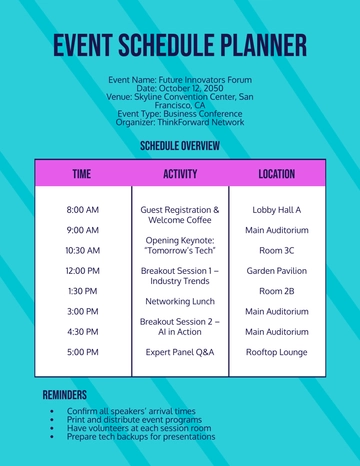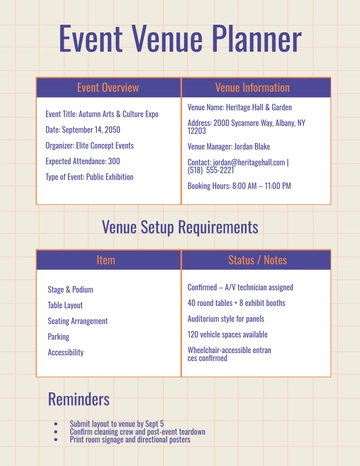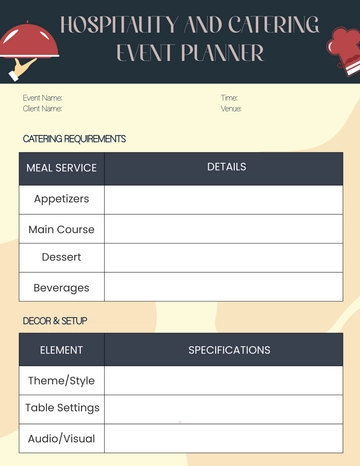Free Event Planner Emergency Plan

1. Introduction
This Emergency Plan outlines the procedures to ensure the safety and well-being of all attendees, staff, and participants at events organized by [Your Company Name]. It serves as a comprehensive guide to managing various emergencies, including medical incidents, fire hazards, natural disasters, and security threats. The goal of this plan is not only to protect individuals but also to minimize disruption and maintain a safe environment conducive to the event's success.
2. Purpose and Objectives
The primary purpose of this Emergency Plan is to ensure the safety and security of everyone involved in our events. The objectives include:
Prevention: Identifying potential hazards and implementing measures to prevent incidents before they occur.
Preparedness: Ensuring all staff are trained and equipped to handle emergencies effectively, thereby reducing panic and confusion during crises.
Response: Outlining clear protocols for responding to emergencies swiftly and efficiently, ensuring that all attendees receive appropriate care and support.
Recovery: Facilitating a quick return to normal operations following an incident, thereby maintaining trust and confidence among attendees and stakeholders.
3. Emergency Response Team
To effectively implement this Emergency Plan, an Emergency Response Team (ERT) will be established, comprising:
Event Safety Officer: Responsible for overseeing the execution of the Emergency Plan, coordinating responses, and serving as the main point of contact for external emergency services.
Medical Coordinator: A trained medical professional who will manage all medical emergencies, ensuring that first aid stations are adequately staffed and equipped.
Security Lead: The individual tasked with overseeing security personnel, assessing threats, and implementing necessary security measures.
Logistics Manager: This person will coordinate resources, such as supplies and equipment, ensuring they are readily available for emergency situations.
Regular training sessions will be conducted to ensure all team members understand their roles and responsibilities within the ERT. Additionally, annual drills will be held to simulate emergency situations, allowing the team to practice their response strategies and identify areas for improvement.
4. Risk Assessment
4.1 Identification of Risks
A thorough risk assessment will be conducted for each event, identifying potential hazards such as:
Medical emergencies (e.g., allergic reactions, cardiac events)
Fire hazards (e.g., cooking equipment, electrical failures)
Natural disasters (e.g., earthquakes, severe storms)
Security threats (e.g., unauthorized access, potential violence)
By identifying these risks early, we can develop tailored strategies to mitigate their impact. For example, collaborating with local emergency services to ensure rapid response capabilities during the event can significantly enhance attendee safety.
4.2 Evaluation of Risks
Each identified risk will be evaluated based on the likelihood of occurrence and potential severity of consequences. This evaluation will inform the prioritization of resources and training efforts. Risks classified as high severity and high likelihood will receive immediate attention, whereas lower-priority risks will be monitored and reviewed periodically.
5. Communication Plan
5.1 Communication Channels
Multiple channels will be utilized to disseminate information quickly and efficiently:
PA System: The venue’s public address system will be employed to make announcements during emergencies, ensuring that all attendees receive real-time updates.
Mobile Alerts: Attendees will be encouraged to opt into a mobile alert system to receive instant notifications via text message or app alerts.
Social Media: Official social media channels will be updated regularly to keep attendees informed of any developments, ensuring transparent communication during crises.
5.2 Key Messages
Key messages will be pre-determined and readily available to ensure consistency in communication. These messages will include instructions for evacuation, updates on emergency situations, and information about medical assistance. Training sessions will also cover how to effectively communicate during high-stress situations, focusing on clarity and calmness to reduce panic among attendees.
6. Evacuation Procedures
6.1 Evacuation Routes and Maps
Detailed maps of evacuation routes will be prominently displayed throughout the venue and distributed in welcome packets. Staff will conduct thorough inspections of these routes prior to the event, ensuring they are clear of obstacles and well-lit. Familiarizing attendees with these routes during opening announcements will enhance preparedness.
Evacuation drills will be conducted to familiarize staff and attendees with these routes, ensuring everyone knows where to go in case of an emergency. These drills will include discussions on what to expect during an actual emergency, aiming to alleviate fear and confusion.
6.2 Assembly Points
Designated assembly points will be established at a safe distance from the venue to allow for a clear headcount. Each point will have sufficient space for at least [200] people, ensuring comfort and safety while waiting for further instructions. Signs indicating these locations will be placed along evacuation routes, making them easy to locate even under stress.
Staff members will be stationed at assembly points to assist in gathering and counting attendees. A headcount procedure will be implemented to ensure that no one is left behind during evacuations. This process will include using wristbands or other identifiers to easily track individuals during roll calls.
6.3 Procedures for Individuals with Disabilities
Special consideration will be given to attendees with disabilities, ensuring that all evacuation routes and assembly points are accessible. Trained staff members will be assigned to assist individuals requiring additional support during an evacuation, providing reassurance and guidance. This proactive approach will be outlined in staff training sessions, ensuring all team members are equipped to assist those in need.
7. Medical Emergencies
7.1 On-Site First Aid Stations
At least [two] on-site first aid stations will be established, staffed with certified medical personnel, including registered nurses or emergency medical technicians (EMTs). Each station will be equipped with supplies such as:
Bandages, antiseptics, and gauze for treating minor injuries.
An automated external defibrillator (AED) to provide emergency cardiac support.
Ice packs and burn cream for immediate relief from heat-related injuries.
Basic over-the-counter medications (e.g., ibuprofen, antihistamines) to address common ailments.
The locations of these first aid stations will be clearly marked on event maps distributed to attendees and staff, ensuring everyone knows where to find help. Staff will also receive training on basic first aid to assist until professional help arrives.
7.2 Local Hospitals and Medical Facilities
A list of nearby hospitals and medical facilities will be compiled and shared with event staff. The following hospitals will be included:
City Hospital: [(123) 456-7890], [Address]
Community Medical Center: [(234) 567-8901], [Address]
In case of a serious medical emergency, the Medical Coordinator will facilitate transportation to these facilities as needed, ensuring timely access to advanced care. Furthermore, staff will be trained to communicate effectively with emergency services, relaying necessary details quickly to minimize response times.
8. Fire Safety Plan
8.1 Fire Prevention Measures
To prevent fire-related incidents, the following measures will be implemented:
Regular Inspections: Fire extinguishers and alarms will be inspected monthly to ensure they are in proper working condition. Each fire extinguisher will have a service tag indicating the last inspection date. This will be part of the venue's ongoing maintenance routine to identify and address potential issues proactively.
Prohibition of Flammable Materials: All flammable materials will be stored in designated, clearly labeled areas. Vendors will be informed of fire safety regulations during pre-event meetings, ensuring they understand the importance of adhering to these guidelines to protect everyone present.
8.2 Fire Response Protocol
In case of a fire, the following protocol will be enacted:
Immediate Alarm: The nearest staff member will activate the fire alarm system and call emergency services 911, initiating the response protocol.
Evacuation: Staff will guide attendees to the nearest evacuation route, ensuring that they stay calm and orderly. Emergency exits will be illuminated, with signs clearly indicating directions to facilitate a swift and safe exit.
Fire Department Coordination: The Event Safety Officer will liaise with the fire department upon their arrival to provide information about the venue layout and potential fire sources, ensuring they have all necessary details to address the situation effectively.
9. Weather-Related Emergencies
9.1 Inclement Weather Procedures
To manage weather-related emergencies, the following protocols will be established:
Monitoring System: A weather monitoring system will be set up, including access to local weather channels and alerts. Staff will be trained to recognize severe weather warnings and take appropriate action, including relocation of events or sheltering attendees as necessary.
Severe Weather Announcements: If severe weather is anticipated, announcements will be made via the PA system to inform attendees of safety measures and potential evacuations. A dedicated weather response team will monitor conditions throughout the event, ready to act based on real-time updates.
9.2 Severe Weather Shelter Areas
Designated shelter areas will be equipped to accommodate attendees during severe weather events. These areas should be capable of housing at least [150] people, with provisions for seating and supplies such as bottled water and non-perishable snacks. Staff will be trained to guide attendees to these areas quickly and efficiently, ensuring their safety and comfort.
10. Power Outages and Utility Failures
10.1 Power Failure Protocol
In the event of a power outage, the following protocol will be followed:
Immediate Assessment: The Event Safety Officer will assess the situation to determine if the power outage is localized or widespread. Backup generators will be activated within [10 minutes] to support critical functions like lighting and communication systems. Staff will maintain communication with venue management to receive updates on the outage status, ensuring everyone remains informed throughout the process.
Emergency Lighting: Battery-powered emergency lights will be activated, illuminating exit routes and ensuring attendees can evacuate safely. Staff will guide attendees calmly to designated safe areas until power is restored or evacuation is necessary.
10.2 Communication During Outages
During power outages, communication will be maintained through backup systems, such as portable radios, ensuring that information can be relayed to attendees. Staff will be trained to communicate clearly and reassure attendees, emphasizing that their safety is the top priority. Additionally, they will utilize mobile devices to send updates through social media and text messaging systems, keeping everyone informed of the situation.
- 100% Customizable, free editor
- Access 1 Million+ Templates, photo’s & graphics
- Download or share as a template
- Click and replace photos, graphics, text, backgrounds
- Resize, crop, AI write & more
- Access advanced editor
Prepare for contingencies with the Event Planner Emergency Plan Template from Template.net. This editable and customizable template helps outline safety protocols and emergency procedures for events. Use our Ai Editor Tool to ensure a solid emergency response plan.
You may also like
- Aesthetic Planner
- Hourly Planner
- Daily Planner
- Weekly Planner
- Monthly Planner
- Planners Yearly
- Event Planner
- Project Planner
- Calendar Planner
- Student Planner
- School Planner
- Teacher Planner
- Kawaii Planner
- Budget Planner
- Life Planner
- Meal Planner
- Study Planner
- Business
- Workout Planner
- Work Schedule Planner
- Party Planner
- Social Media Planner
- Baby Shower Planner
- Book Planner
- Planner Cover
- Debt Planner
- Desk Planner
- Diet Planner
- Family Planner
- Fitness Planner
- Goal Planner
- Health Planner
- Medical Planner
- Holiday Planner
- Homework Planner
- Itinerary Planner
- Journal Planner
- Personal Planner
- Route Planner
- Smart Goal Planner
- Travel Planner
- Wedding Planeer





























